AMD’s GTX 560 Ti Counter-Offensive: Radeon HD 6950 1GB & XFX’s Radeon HD 6870 Black Edition
by Ryan Smith on January 25, 2011 12:20 PM ESTPower, Temperature, & Noise
As was the case with gaming performance, we’ll keep our running commentary thin here. The Radeon HD 6950 1GB is virtually identical to the 2GB card, so other than a few watts power difference (which can easily be explained by being an engineering sample) the two are equals. It’s the XFX Radeon HD 6870 Black Edition that has caught our attention.
| Radeon HD 6800/6900 Series Load Voltage | |||||
| Ref 6870 | XFX 6870 | Ref 6950 2GB | Ref 6950 1GB | ||
| 1.172v | 1.172v | 1.1v | 1.1v | ||
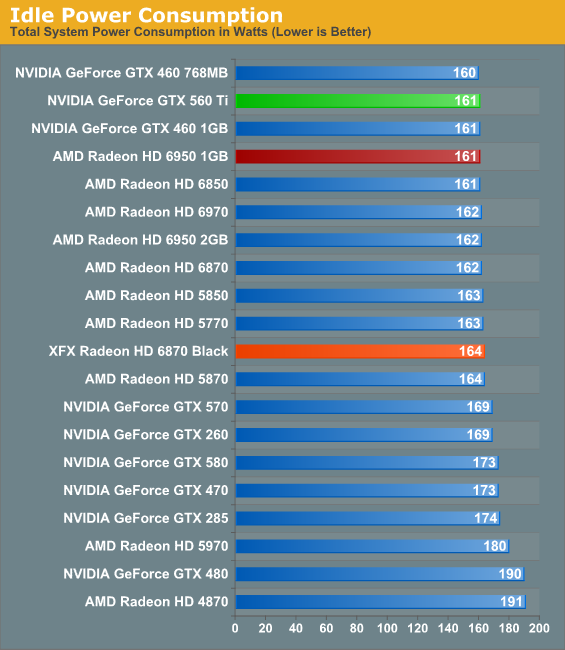

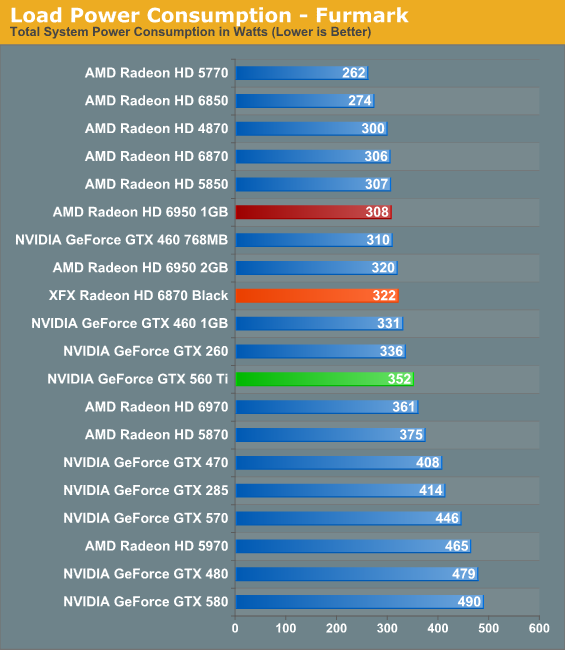
While the XFX 6870 has the same load voltage as the reference 6870, between the change in the cooler and the higher core and memory frequencies power usage still goes up. Under Crysis this is 11W, and under FurMark this expands to 16W. Unfortunately this factory overclock has wiped out much of the 6870’s low power edge versus the 6950, and as a result the two end up being very close. In practice power consumption under load is nearly identical to the GTX 460 1GB, albeit with much better gaming performance.
Meanwhile this is one of the few times we’ll see a difference between the 1GB and 2GB 6950. At idle and under Crysis the two are nearly identical, but under FurMark the 1GB reduces power consumption by some 12W even with PowerTune in effect. We believe that this is due to the higher operating voltage of the 2Gb GDDR5 modules AMD is using on the 2GB card.
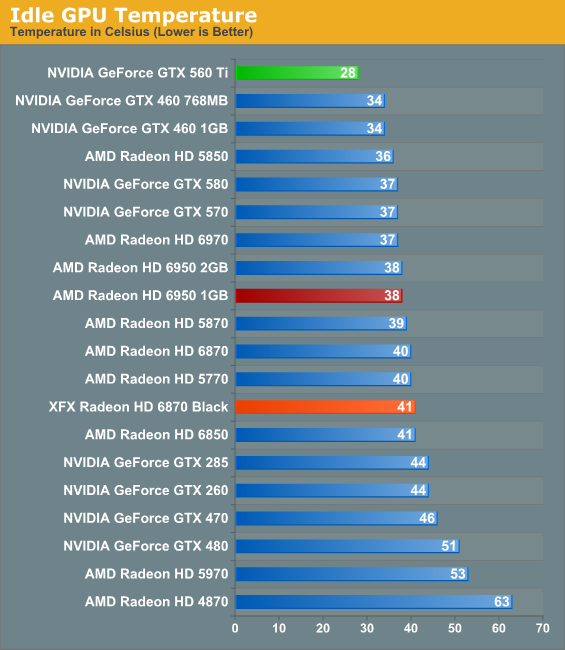


As far as temperatures go both cards are in the middle of the pack. The vapor chamber cooler on the 6900 series already gives it a notable leg up over most cards, including the XFX 6870. At 41C the XFX card is a bit warm at idle, meanwhile 78C under load is normal for most cards of this class. Meanwhile the 6950 1GB and 2GB both perform identically, even with the power consumption difference between the two.
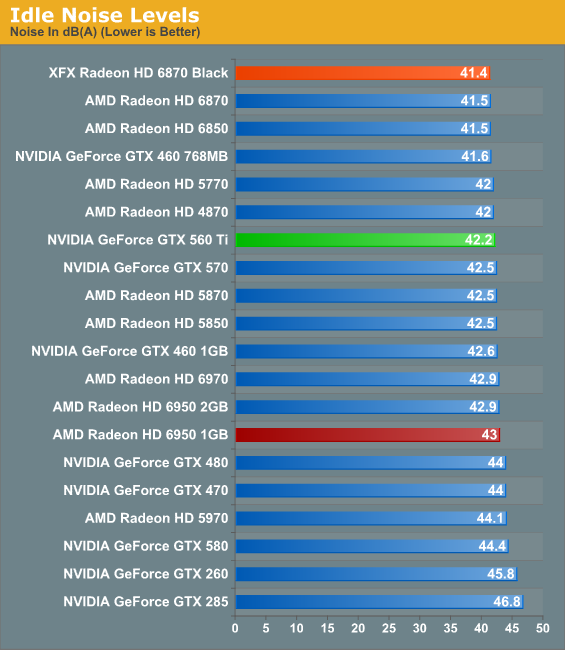
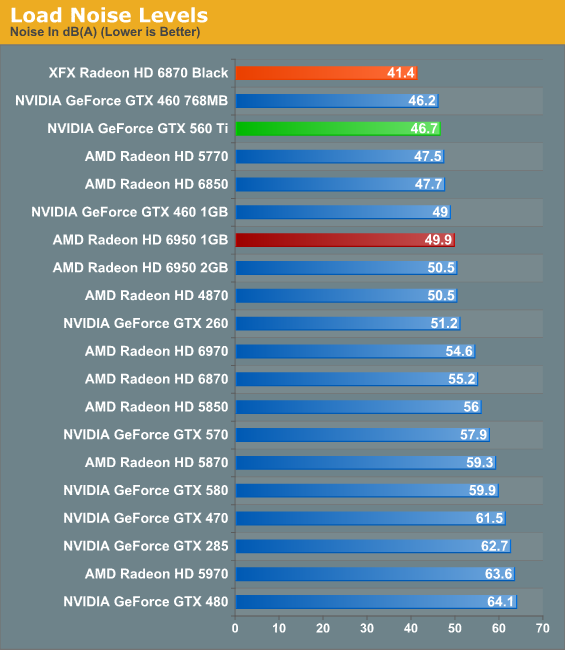
Last but certainly not least we have our noise testing, and this is the point where the XFX 6870 caught our eye. The reference 6870 was an unremarkable card when it came to noise – it didn’t use a particularly advanced cooling design, and coupled with the use of a blower it ended up being louder than a number of cards, including the vapor chamber equipped Radeon HD 6970. The XFX 6870 reverses this fortune and then some due to XFX’s well-designed open-air cooler. At idle it edges out our other cards by a mere 0.1dB, but the real story is at load. And no, that’s not a typo in the load noise chart, the XFX Radeon HD 6870 Black Edition really is that quiet.
In fact at 41.4dB under load, the XFX 6870 is for all intents and purposes a silent card in our GPU testbed. Under load the fans do rev up, but even when doing so the card stays below the noise floor of our testbed. Compared to the reference 6870 we’re looking at just shy of a 14dB difference between said reference card and the XFX 6870, a feat that is beyond remarkable. With the same warning as we attach to the GTX 460 and GTX 560 – you need adequate case cooling to make an open-air card work – the XFX Radeon HD 6870 Black Edition may very well be the fastest actively cooled quiet card on the market.
Meanwhile for the Radeon HD 6950 1GB and 2GB, we’re once again left with results that are nearly indistinguishable. Under load our 1GB card ended up being .6dB quieter, an imperceptible difference.










111 Comments
View All Comments
Ryan Smith - Wednesday, January 26, 2011 - link
Indeed CPU bottlenecking is a concern, and we always try to remove it as much as possible. Replacing the CPU means throwing out our entire body of work, so as important as it is to avoid being CPU bottlenecked, we can't do it frequently.The issue for us right now is that SNB-E isn't due until late this year, and that's the obvious upgrade path for our GPU testbed since SNB has a limited amount of PCIe bandwidth.
7upMan - Wednesday, January 26, 2011 - link
RYAN: Hi Ryan, while I usually find AnandTech articles quite entertaining and informative, I always wonder why the f*ck professional editors won't get it into their head to test 2GB cards in areas where they belong to. Meaning: a 2GB vs. 1 GB card test should be about graphically overly intensive games and game mods, like the Half-Life 2 Fake Factory mod, or the STALKER Complete mod (Oblivion too has such mods). There are a number of other mods that put massive numbers of huge textures into the graphics RAM, and I think they should be the ones you need to test the cards with. After all, you can't expect games that were written with 1GB VRAM in mind to utilize the full power of double VRAM.So please, please run some tests with the above mentioned mods. Thanks in advance.
IceDread - Wednesday, January 26, 2011 - link
Good reviewAs a sidenote, sort of fun to see my one year old card 5970 is still the best when looking at single cards.
IceDread - Wednesday, January 26, 2011 - link
There was not much talk about SLI and crossfire btw, there the value in AMD is higher today day with a fair bit than with SLi solutions comparing AMD 6xxx series with new nvidia cards.Ryan Smith - Wednesday, January 26, 2011 - link
We had to leave our SLI & CF for this article because of all the driver changes from both parties - as it stands I need to rerun most of those numbers.You'll be seeing a lot more on SLI and CF in a week or two; we have a trio of 580s and 6970s in house for some tri-SLI/CF testing.
Scootiep7 - Wednesday, January 26, 2011 - link
Not going to add much to the discourse at this point. I just want to say that I really liked this article and thank you for your time and due diligence in writing it.blackshard - Wednesday, January 26, 2011 - link
Why they are so different from previous articles? NVIDIA numbers have grown about three times and some AMD numbers are grown too.Previous article about HD6950 and HD6970 showed this:
http://www.anandtech.com/show/4061/amds-radeon-hd-...
Ryan Smith - Wednesday, January 26, 2011 - link
In the GTX 560 Ti article I explained what was going on.http://www.anandtech.com/show/4135/nvidias-geforce...
"Small Lux GPU is the other test in our suite where NVIDIA’s drivers significantly revised our numbers. Where this test previously favored raw theoretical performance, giving the vector-based Radeons an advantage, NVIDIA has now shot well ahead. Given the rough state of both AMD and NVIDIA’s OpenCL drivers, we’re attributing this to bug fixes or possibly enhancements in NVIDIA’s OpenCL driver, with the former seeming particularly likely. However NVIDIA is not alone when it comes to driver fixes, and AMD has seem a similar uptick against the newly released 6900 series. It’s not nearly the leap NVIDIA saw, but it’s good for around 25%-30% more rays/second under SLG. This appears to be accountable to further refinement of AMD’s VLIW4 shader compiler, which as we have previously mentioned stands to gain a good deal of performance as AMD works on optimizing it."
blackshard - Wednesday, January 26, 2011 - link
Ok, got it. I have not read the gtx560 review. Thanks ;)ibudic1 - Wednesday, January 26, 2011 - link
Don't forget that you can unlock 6950 to 6970, at which point Nvidia is just NOT competitive.http://www.techpowerup.com/137140/AMD-Radeon-HD-69...